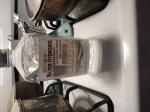Colloidal Silver - Ions, Atoms, Crystals or Salts?
By Fred Peschel
Reprinted with permission
Everyone seems to stretch the facts (as we used to) or gets generic (we must)about colloidal silver, Here are the real researched facts about what colloidal silver is and should be.(Taken partly from our colloidal silver web page, the works of Francis S. Key and George Maass, PhD, http://www.ucalgary.ca/~schramm/intrcoll.html) and others.
First of all we must explain that basically:
a colloid is a "suspension of one material in another"!
Classical colloid science deals with dispersions for which at least one dimension of a dispersed phase falls within about 1 and 1000 nm (0.001 to 1 micron). (In applied colloid science the upper size limit is commonly extended to at least 10,000 to 100,000 nm. (10 or 100 microns)
In the case of colloidal silver, it is solid particles (of silver) in a liquid (water). It is not in fact a suspension, as the definition of a suspension is particles larger then 1 micron (1,000 nanometers) while colloidal particles are defined as 1 nm to 1,000 nm and a solution (ions) is defined as particles less then 1 nm in diameter. An ion or atom of silver is about 1/4 nm diameter! One nm being a billionth of a meter or 1/1,000th of a micron (millionth of a meter)!
Thus, the largest allowed colloidal particle of 1,000 nm would contain about 45,000,000,000 atoms or ions of silver (D cubed X pi/4)! Think of your colloidal silver (ionic) as silver bullets for shooting at an army of bacterium - would you rather have one fat canon ball or 45 billion bullets? Yes, some hopeless hackers make "medicine" 45 billion times less effective then it can be!
It is said that an ounce of 5PPM ionic colloidal silver has over 1,000 trillion ions, which far exceeds our number of body cells! Thus, a tablespoon of 5PPM ionic is more then enough!
The ideal then, is to have as many ions as possible, since they could yield as many as 45 billion times more discrete particles, enhancing bio-activity from both quantity and size aspects! The more typical, large colloidal silver particle of 200 nm would contain 380 million ions or atoms! The very best colloidal silver will have over 99% ions but in practice most has far less, due to lack of understanding of what variables must be closely controlled to prevent formation of atoms, crystals or salts! Those that "salt" the water or "look for a cloud of ions" are doomed to producing very few to no ions of silver and thus "a very very weak medicine"!
What is popularly refered to as colloidal silver is in fact usually a combination of ions (dissolved), atoms (colloidal), crystals (suspended but usually settle out) and salts of silver (rarely dissolved and usually settle out). Soluable silver salts, like silver nitrate, provide free ions of silver but also dangerous nitrate ions!
The best bio-availability is from the ionic form, with rapidly decreasing biological benefits from the other forms, the ionic form being 300 times more effective to 17,000 times more effective then many silver salts! Put another way, you would need a daily dose of 1 to 50 gallons of "poor quality" Cs to equal a tablespoon of 5 PPM ionic silver!
Ion of silver - an atom, missing one (most common, monovalent) or more electrons. It has distinctly different properties then metallic silver and is actually in solution, and thus not colloidal. Carries a positive, ionic electrical charge, being short one or more electrons and thus very bio-active.
Atom of silver - the smallest particle of silver and it has a negative surface charge in a colloidal state. This charge is like a static charge, which has minor biologic benefits.
Crystal of silver - many silver atoms chemically bonded together. They may have a negative surface charge in a colloidal state but are usually too large (will continue growing) and will settle out.
Salts of silver - chemically bonded silver ions to other materials that were dissolved in the starting water. They are usually poorly soluable and thus form crystal growths and settle out.
nm = nanometer or billionth of a meter. 1/1,000 inch is roughly 25,000 nanometers!
A popular measure of the existence of a colloid, such as colloidal silver, (but not milk, which is also a colloid) is the Tyndal effect of "the dispersion of a light beam shown thru the liquid". A cloudy path of the light beam will be evident if there are colloidal particles in suspension! It is visible in colloids as weak as 0.1 PPM. Ions, the preferred form of silver, are NOT visible, even with a high powered microscope!
Thus, a strong Tyndal effect is an indication of larger silver particles and thus less bioavailability while a weak Tyndal effect indicates more ions of silver, assuming you are comparing the same PPM.
PPM, by the way, is a measure of "parts by weight", so it cares less if ionic, atomic, crystaline or salts of silver. Ion Specific Electrodes can measure the ionic particles only, while atomic absorption can measure them all. A centrifuge can separate out the particles of a colloid, leaving the dissolved ions. The common measurement of solution conductivity, using low cost PPM meters, will measure only the charged particles. These will include colloidal silver particles (atoms or clusters of atoms), silver ions and dissolved salts (which disassociate into charged ions), but will not measure any crystals or non-charged atom clusters. The measurement is in microsiemens/centimeter and for colloidal silver converts at 1.6 uS/PPM.
Ions are inherently produced, by well controlled low voltage electrolysis, but when they reach the negative electrode they gain an electron and become an atom of silver and/or join to others to make crystals of silver. These are weak crystal structures, like snow flakes, and may fall off the electrode if disturbed.
If current density (uamp/cm) is not controlled properly, there will be few ions stripped off the silver electrode and the disruptive energy will knock off mostly atoms or chunks (crystals) of silver. Further, if circulation is not used, a conducting string of ions/atoms will bridge between the electrodes and crystal growth will proceed in between the electrodes! This then leads to very high current density (point discharge of current), negating any current limiter (constant current) benefits!
The measure of the stability of a colloid is the zeta potential or particle charge! It is a negative surface charge, unlike the positive ionic charge (due to loss of an electron) of ionic silver. Since like charges repel the particles stay separated, for good stability. It is possible to have both positive and negatively charged particles in a solution, just as salt disassociates into + sodium and - chloride ions. In the solvating action of water, ions are surrounded by micelle of water, greatly reducing their mobility!
In summation, the ionic (positively charged) form will have the highest bio-availability and bio-activity of any form of silver. It can not be produced in high PPM due to the limited soluability of silver ions in water (metallic silver is not soluable in water but can be suspended in colloidal form). That is, when the saturation point is reached (about 15-20 PPM) precipitation will occur. Higher concentrations (to 500+ PPM) can be made if bound to protein, but the ions are surrounded and thus have their bioactivity masked, allowing mold growth on the protein surface.
The only real measure of quality of Cs is its effectiveness or bio-availability and bio-activity! Basically the particles must have a charge and be of minimal size!
A perfect "colloid" would have no ions and would thus have very low bio-activity, as it is the missing electron of a silver ion that provides the "killing" power of so called colloidal silver. Properly manufactured (ionic) "colloidal silver" can penetrate your tissues and kill off most viruses or bacteria or stop an immune system reaction from irritants like poison ivy or a burn!
Fred Peschel, Researcher, Engineer and Inventor












